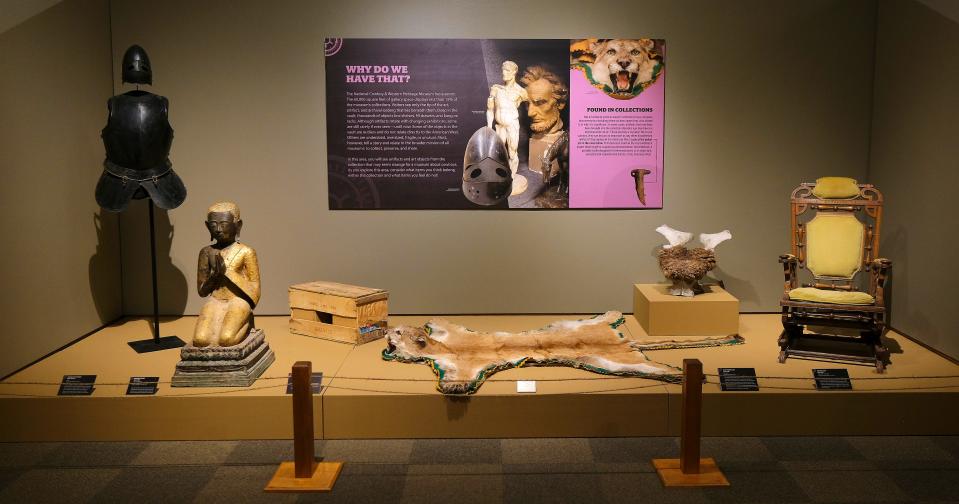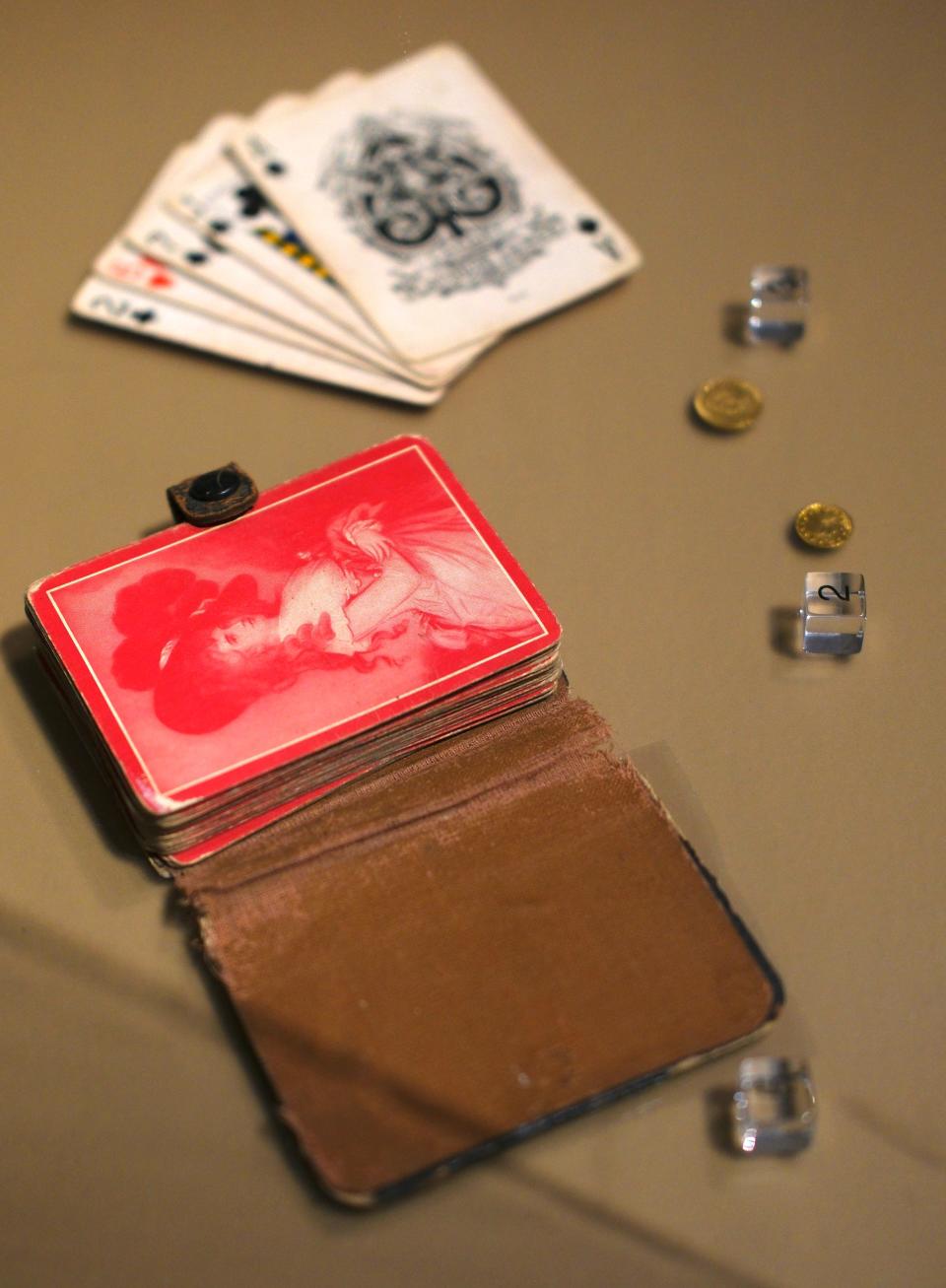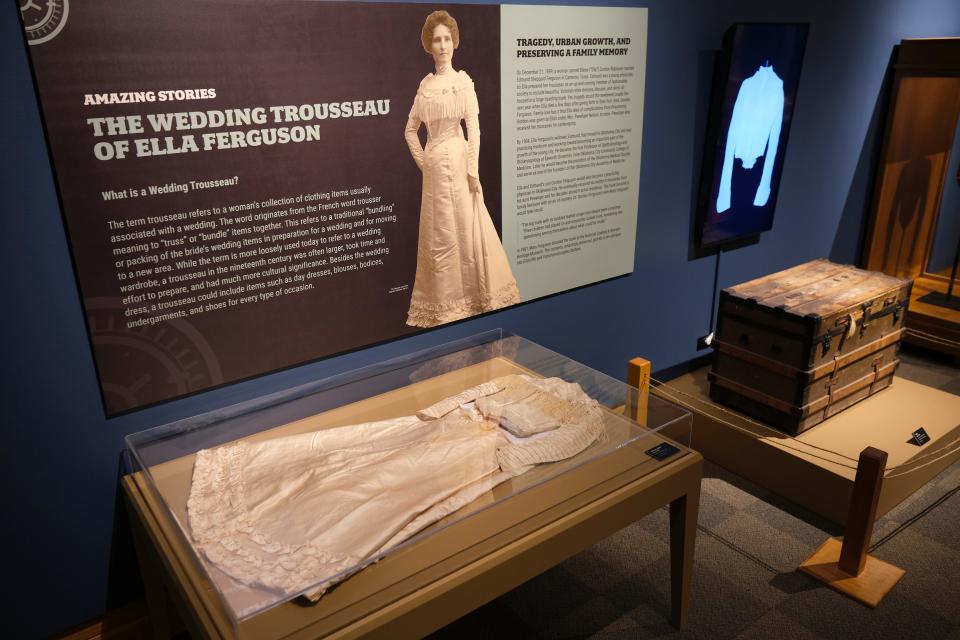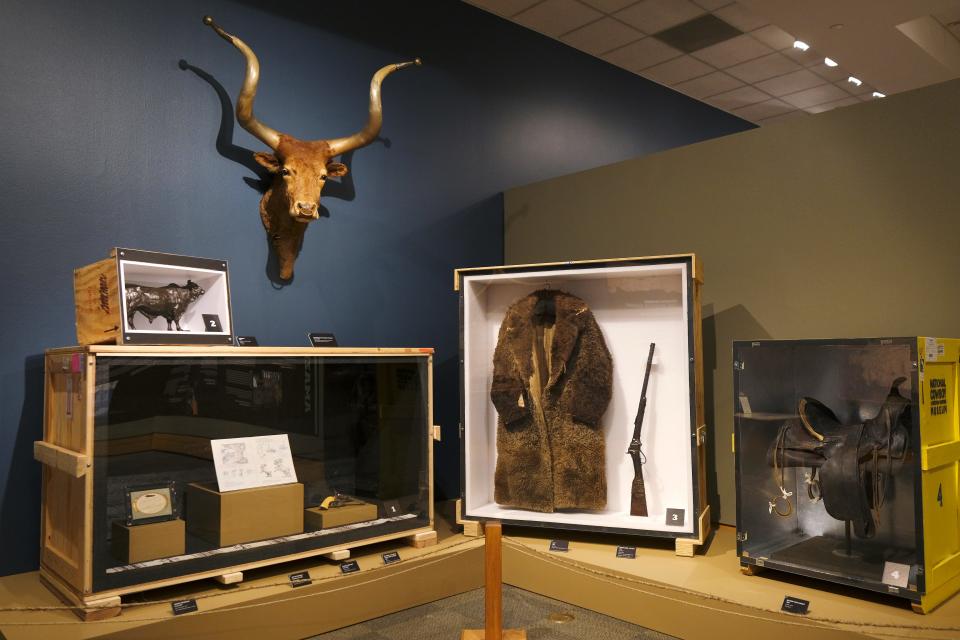From a death mask to a lock of hair, OKC cowboy museum shows 'Treasures' and oddities
A pair of presidential Tony Lama boots custom-made for Ronald Reagan, a gnarly chair fashioned from six sets of elk antlers bolted together and a hefty Southeast Asian Buddhist statue once owned by John Wayne might seem like strange items to find on view at the National Cowboy & Western Heritage Museum.
Of course, the lock of baby hair from the late artist Joe De Yong (1894-1975) and the plaster death mask of celebrated "The End of the Trail" sculptor James Earle Fraser, created by his wife and fellow artist Laura Gardin Fraser, might be considered even stranger things to find in a museum exhibition.
What's arguably stranger still is that the eclectic selection of artworks and artifacts in the exhibit "Treasures from Our Atherton Vault" represents just a tiny fraction of the more than a million archival documents, nearly 25,000 historic objects and about 800,000 photographs in the collection of the National Cowboy Museum, 1700 NE 63rd St.
"Our 60,000 square feet of gallery space only exhibits around 15% of the museum’s collection at any one time. ... So, the cool thing is this just scratches the surface," said Chief Curatorial Officer David Davis. "This was a fun variety show, and we could just keep doing this on and on, because there's just so much of it down there in that vault."

How does the exhibit tie into the OKC museum's $40 million capital campaign?
On view through April 28, "Treasures from Our Atherton Vault" is showcasing some of the most unique, quirky and delicate items in the The Cowboy's vast collection at a time when expanding the vault is a major focus for the museum's staff and leadership.
Last year, the Oklahoma City landmark embarked on its most comprehensive capital campaign since the 1990s. Visitors to the National Cowboy Museum can't miss the construction in the parking lot and West Hallway and the new "The Code of the West" interactive exhibit in the museum's East Hallway.
But the $40 million "Live the Code" capital campaign also includes plans to expand, modernize and improve the museum's Art and Artifacts Vault with high-density storage to maximize the use of the facilities. Set to grow from 11,500 square feet to 19,000 square feet, the Art and Artifacts Vault is expanding into the lower-level staff parking lot as originally designed by the building’s architect.
"The whole capital campaign, of course, has multiple layers ... but the vault is one of the biggest ones. And it's one of the most critical for us, because it's a lot of infrastructure that we need," Davis said. "So, this is almost almost doubling our vault in size ... and then along with this — and probably the most expensive part — is all the HVAC stuff that we're replacing."

The vault's new HVAC system and plumbing will ensure proper environmental standards will be maintained to protect the museum’s collection.
"This building has been around for a long time ... and the air-handling systems and the air controls specifically for the vault are really important to us," Davis said. "The worst thing for us is any kind of fluctuations in relative humidity and temperature. That's what kills our artifacts."
As part of the "Live the Code" campaign, longtime supporters the William S. and Ann Atherton Foundation earlier this year gave the museum substantial grant funding to renovate, expand and enhance the Art and Artifacts Vault. Although the exact amount wasn't disclosed, the foundation's contribution is described as "a transformational gift" and warranted museum leadership naming it the William S. and Ann Atherton Vault.
In addition to the Art and Artifacts Vault, the museum's Dickinson Research Center has its own vault that is getting expanded and upgraded as part of the campaign. The Dickinson Research Center storage space houses 800,000 photographs, 45,000 books, 3,000 audio-visual objects and 800 archival collections.

What other unusual items are included in the exhibit 'Treasures from Our Atherton Vault?'
With so much focus on revamping the vault, Seth Spillman, the museum's chief marketing officer, said the time seemed right for an exhibit giving visitors a rare glimpse into the extensive array of items in the museum's collection that typically stays tucked away in storage.
"People don't really understand that ... what they see on exhibit throughout the museum, I don't even want to say it's the tip of the iceberg. It's a couple of cubes on the tip of the iceberg of what we have here," Spillman said.
Just as the mystique of the vault makes these kinds of exhibits popular among visitors, Davis said they're also fun for museum staffers. The curators often relish the chance to showcase items that are seldom seen by the public, from a high wheeler bicycle dating to circa 1880 to Muscogee and Seminole artist Jonny Hawk's (1938-2022) enormous wall-spanning 1972 painting "Child of the Eagle."
"An item just sometimes doesn't ever really fit into any of the thematic ideas that our curators have," Davis said. "There can be a variety of reasons ... and the fragility (of some items) is a big reason."

"Treasures from Our Atherton Vault" features a West Mexican effigy figure dating from 100 B.C. to A.D. 250, a reproduction set of Spanish-style metal armor and the mounted twisted-horned head of Bobcat Twister, billed as the “Famous Educated Steer."
Along with the bronze and gold Buddhist statue gifted to the museum from Wayne, the exhibit includes the custom Winchester rifle The Duke used in the 1969 film "True Grit," a yellow-hued rocking chair Walter Brennan used in the 1957-63 television comedy "The Real McCoys" and a typewriter and pair of boots from the Sam Peckinpah archive the museum acquired in 2022.
Although some visitors might have trouble regarding a late 19th-century apothecary jar still half-filled with peppermints as a treasure, Davis said there's no doubt that a handwritten journal from 1868 by a cowboy who was actually on a cattle drive is priceless.
"It's maybe the earliest handwritten journal of anybody on an actual cattle drive. This predates the establishment of the cattle trails like the Chisholm Trail and others. This was just post Civil War, and they were pushing some cattle from North Texas, up through the Indian territory, which is Oklahoma, and up into southern Kansas at the end," Davis said.
"So, that tells every day of that journey and his experiences ... so it's so important as a historical reference."
'TREASURES FROM OUR ATHERTON VAULT'
When: Through April 28.
Where: National Cowboy & Western Heritage Museum, 1700 NE 63.
Tickets and information: https://nationalcowboymuseum.org.
This article originally appeared on Oklahoman: OKC's National Cowboy Museum shows off 'Treasures' from its vault
